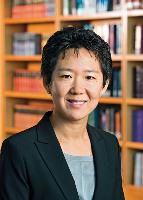Mastering the Mechanics of Biology
Internationally-renowned researcher Professor Li Rong takes over as director of the NUS Mechanobiology Institute — and looks to employ novel approaches to make further advances in our understanding of cellular dynamics.

Imagine a world where cancer is a thing of the past, where scientists can grow new lungs for you, from your own cells, should you need a transplant. These scenarios could one day become a reality, all thanks to advances made in a field known as mechanobiology. With its focus on the physical and mechanical aspects of biological functions, mechanobiology is a relatively new term. And if you were to do a Google search on it, the top results would be for the website of NUS Mechanobiology Institute (MBI) — which is appropriate given that this institution was ahead of its time when it was founded in 2009. Ten years on, mechanobiology remains at the frontier of interdisciplinary science.
According to MBI, innovation in biological research arises from bringing new approaches and technologies to old questions about how biological systems work. MBI has tried to do this by combining the expertise of physicists, engineers and biologists in an environment where they have access to the latest nano- and micro-fabrication facilities. They also have access to the latest light microscope technologies to answer fundamental questions about biological systems. The best science requires the best instruments and infrastructure. Just think about the recent imaging of a black hole that made headlines worldwide, made possible by advances in telescope technology.
It should go without saying, then, that the function of any scientific endeavour is to probe the physical world and to ask relevant questions. Here are a few of the questions that drive the work at MBI: How does the mechanical environment influence embryo development and pattern formation? Can mechanical cues be exploited in the next generation of tissue-engineering technologies?
These questions relate to the ongoing challenge of understanding how cells organise themselves into specific patterns, eventually resulting in complex structures such as organs and bones. If we can understand these processes, it may be possible to engineer solutions to cancer, and the creation of new organs, as mentioned at the start.
These are profound questions, and anyone coming to the table is going to add other interesting scenarios to explore. As MBI welcomes its new director, Professor Li Rong, it will certainly be exploring even more interesting questions. “What I’m intrigued about is the robustness of biological systems and evolvability,” says Prof Li. “How can a biological system be stable and yet also be able to change?”
THE ART OF THE CELL
What I’m intrigued about is the robustness of biological systems and evolvability. How can a biological system be stable and yet also be able to change?
Prof Li Rong
Prof Li is a distinguished scientist, and a leader in the study of cellular dynamics and mechanics. MBI prides itself on enabling and encouraging interdisciplinary interaction, and Prof Li has embraced this approach throughout her career. Her work in examining cellular dynamics has employed integrated approaches encompassing biochemistry, genetics, quantitative imaging and fluorescence spectroscopy, mathematical modelling, quantitative genomics and proteomics (large-scale study of proteins).
Under Prof Li’s leadership, MBI will expand its ongoing research into new areas and continue to be a vibrant hub of international collaboration. Its overarching goal is to achieve a deeper understanding of growth, development and ageing, and to explore new approaches for the treatment of human diseases. Practically speaking, these all relate to cellular engineering, which is an area that MBI strongly focuses on, according to Prof Li.
Her colleagues at MBI expand on this point, noting that asymmetry at the cellular level forms a foundation to establish the blueprint for patterning tissues and organs along the body axes (e.g. head-to-toe and left-to-right) during development. Cellular asymmetry is also critical for organ/tissue homeostasis and prevention of tumorigenesis throughout postnatal life. And what does it all mean for the man in the street? Simply put, a better understanding of this process will not only aid in improving our basic understanding, but will also be a stepping stone towards designing treatments against developmental disorders and advanced tumours. “What we want to do at MBI is find out how we can build tissues, and how we can regenerate tissues. To do this, we will have to induce asymmetry at the cellular level. If we start with stem cells, embryonic stem cells or even intestinal stem cells, for example, they don’t begin with asymmetry. At some point there is a symmetry-breaking process, which gives rise to different progeny and functions. Establishing asymmetry in the right pattern — that leads to correct tissue organisation — is what we want to do,” explains Prof Li.
This is all part of the work that Prof Li will be continuing at MBI, taking over from her predecessor Professor Michael Sheetz, founding director of MBI. “I really admire the work of Prof Sheetz in making MBI a world leader. He has assembled a great team of principal investigators to build a world-class infrastructure here. So, to be the next director will be a really easy job!” says Prof Li, in light-hearted praise of Prof Sheetz’s efforts. She hopes to have continued resources to recruit scientists from a worldwide pool, to really enhance existing strengths at MBI. “Singapore is so international… you know we do science all over the world, not just in one country. Also, as Singapore is a young country, there is less of a chance for existing traditions to stifle innovation. Besides funding and infrastructure, it is really the scientists who make the difference, who come up with big ideas. The government has a vision to build great science, and to bring in the right talents. MBI is already very visible as a leader in this relatively new field. Singapore is really the perfect place for bringing creative talents together and building collaborations,” Prof Li adds.
ABOUT PROF LI RONG

Prof Li Rong joins MBI from Johns Hopkins University, where she was Bloomberg Distinguished Professor at the School of Medicine and the Whiting School of Engineering. She was also the director of the Center for Cell Dynamics at the School of Medicine’s Institute for Basic Biomedical Sciences.
Prof Li is a globally-respected leader in the study of cellular dynamics and mechanics. She has made seminal discoveries in the regulation of cell division, cell polarity, the actin cytoskeleton (microfilaments that maintain the shape of cells), aneuploidy (presence of abnormal numbers of genetic materials in cells) and proteostasis (steady state regulation of proteins in the body). The insights gained from her research have contributed to the fundamental understanding of cancer and age-related diseases.
Prof Li has had over 125 papers published in peer-reviewed journals, with many appearing in top-tier publications such as
Cell,
Nature and
Science. Her work has received more than 14,000 citations. Prof Li has served on the editorial boards of
Molecular Biology of the Cell,
Development,
Biophysical Journal, and
BMC-Cell Biology. A little-known fact about Prof Li is that in addition to doing a combined degree in Biophysics and Biochemistry, she also studied fine art. Prof Li studied painting and sculpture, but had to drop fine arts as the university did not allow her to do a triple major.